Doge's Palace Art Story | Location | Opening Hours Tickets | Authorizations
Art Story Power | Tintoretto Paradise | Architecture | Staircases | Senate Collegio | Atrium
The Atrium Square Salon of the Doge's Palace in Venice
The Atrium square is the living room that is located right at the top of the golden staircase of the Doge's Palace.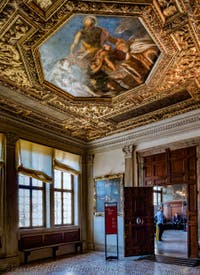
Atrium Square Salon It was the architect and artist Jacopo Sansovino, who at the same time realized (from 1559 to 1567) the golden staircase and the square Atrium, for the Doge Girolamo Priuli.
The doge is represented as it should be on the ceiling of this living room, carrying the sword and scales of Justice, assisted by St Mark in the midst of the clouds!
This central canvas and its sides were painted by Tintoretto, who also made four superb paintings: "The Discovery of Ariane", "Mercury and the Graces", "Pallas that moves away Mars", and "La Forge de Vulcan".
One can imagine the impression of beauty and greatness that seized the visitors of the Palace, ambassadors and Princes, when they arrived at the top of the golden staircase facing these masterpieces.
But that's not what you'll see here. The four paintings of Tintoretto were moved in 1713 to one of the following rooms, the Anticollège Hall.
In 1713, Bertucci Girolamo Contarini bequeathed several paintings to the Republic of Venice.
Four of these bequeathed paintings were installed in the Atrium square instead of the four paintings of Tintoretto.
Three of them, "Christ in prayer, supported by an angel in the Garden of Olives", "Adam and Eve in earthly Paradise" and "Saint John the Evangelist who writes the Revelation", are by Paul Veronese; "The Angel announcing to the shepherds the birth of Christ" is from Bassano.
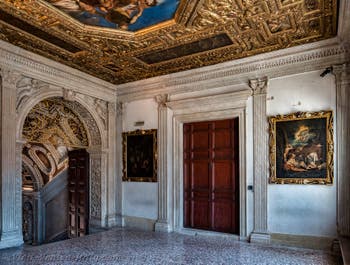
Atrium Square Salon At the fall of the Republic, these four paintings were sheltered in the commandery of the Maltese Order.
Then, with the arrival of Napoleon Bonaparte and the construction of the Procuraties Nuove to be a Royal Palace, these four paintings and others were transported to the Procuraties Nuove to decorate them.
They have now returned to their original place in 1713 and you can see them there again in the Atrium.
Located at the top of the golden staircase, the square Atrium allows access, through a superb door with a large porthole in its centre, to the Anticollege room.
And to the left of the staircase is a door leading to the archives hall of the Council of Ten, a room that previously served as a torture room for the accused.
Because of this sad use, it had been dubbed the "Camera del Tormento", the chamber of torments.
Salon Atrium Square of the Doge's Palace in Venice: Tintoretto
Tintoretto had painted 13 canvases to decorate the Atrium of the Doge's Palace.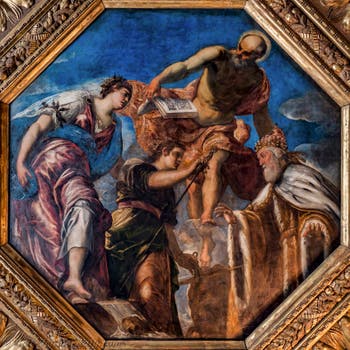
Tintoretto, Doge Girolamo Priuli In addition to the four seasons, the four biblical scenes and the large central canvas where the Doge Girolamo Priuli receives from Justice the scales and the sword, all of which adorn the ceiling of the Atrium, four other paintings of Tintoretto also decorated the walls of this living room:
"The discovery of Ariadne", "Mercury and the Graces", "Pallas that moves away Mars", and "The Vulcan Forge".
Rest assured, they are not lost, but they were moved, in 1713, to the Anticollege room, a few tens of metres from the Atrium square.
They were replaced by three paintings by Paolo Veronese as well as a canvas by Jacopo Bassano.
The magnificent ceiling with gold-covered mouldings that you can admire today, however, remained as it was almost five centuries ago.
The central canvas depicts the Doge Girolamo Priuli, who receives from Justice the scales and the sword, framed by four biblical scenes depicting King Solomon, Samson, Queen of Sheba and Queen Esther.
Finally, four adorable putti, representing the seasons, complete the corners of this ceiling.
Atrium Doge's Palace Venice: Tintoretto, Doge Priuli and Justice
Jacopo Robusti, Tintoretto “The Doge Girolamo Priuli receives from Justice the scales and the sword”
Oil on canvas (2m30 x 2m30) 1565-1567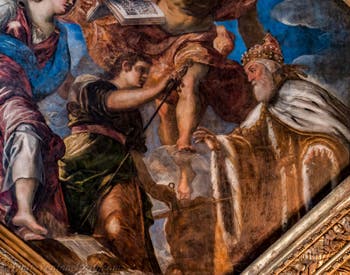
Tintoretto, Doge Girolamo Priuli This octagonal painting adorns the centre of the ceiling of the square Atrium.
A work full of harmonious colours and light, evanescent clouds, transparent shadows, characters particularly present, alive, in relief: we attend the stage, we enter it.
Among the virtues recognized in Doge Girolamo Priuli, doge from September 1, 1559, to November 4, 1567, the date of his death, were clemency and justice.
It is therefore the theme that imposed itself at Tintoretto for the realization of this work intended to highlight the human qualities of this doge, particularly appreciated by this painter.
The doge is represented with hands ready to receive this honour and at the same time one feels his hesitation, am I well worthy to be so distinguished?
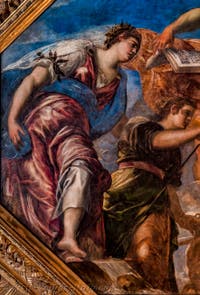
Tintoretto, Justice Justice, meanwhile, is firm in its position, stretches out the sword with one hand and holds the scales in the other.
A stream flows at his feet, in the midst of which stands a rock; an allusion to the word of Zoroaster: the soul emerges from its own wings from the waters of life descending from the four rivers of God's Paradise.
Justice is often represented coming out of the waters of the Euphrates: without water and justice, the land cannot be fertile and generous in fruit.
Giovanni Pico della Mirandola, philosopher, humanist and friend of Laurent de Medici, saw in the waters of the earth the sign of mortal life, unstable, full of turmoil and torment.
Justice is there to correct the gaps and help men overcome the obstacles symbolized by the rock represented by Tintoretto in the middle of the stream in this table.
Tintoretto has therefore taken over these emblems of Justice here.
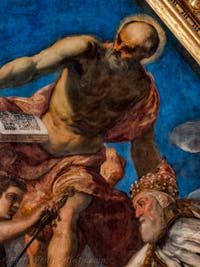
Tintoretto, Saint Mark Next to the virtue of Justice stands Venice, crowned as Justice she presses with her left hand, as if to invite her to honour his doge.
A worthy and serene doge, but also very human, full of wisdom and kindness, richly wrapped in an ermine cloak. The Ducal Corno is covered here with pearls and beaded stones.
One feels the weight of age in his face, this portrait having been painted probably one or two years before his death.
Above the doge, with the lion at his feet and the gospel open, we see Saint Mark, the patron saint of Venice who seems to fly in the midst of clouds, in full motion, clothes floating in the wind: a way of depicting the Saints that characterizes the style of Tintoretto.
He looks at Venice and shows him the doge with his left hand.
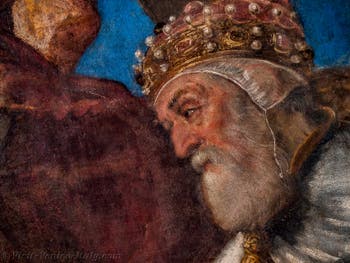
Tintoretto, Doge Girolamo Priuli He is the central character, the one who crowns the scene, Venice and Justice positioned in the base of the oblique pyramid that he forms with them.
The dynamic breathed by Saint Mark is reinforced here by the diagonal that his body forms with the sword of Justice.
And the construction of the painting goes even further, since if you look well, we realize that the alignment of the bodies of Saint Mark and justice, forms exactly a cross with the alignment of the faces of Venice and the Doge.
A symbol of the cross, much more powerful than a painted cross.
A particularly successful work, one of Tintoretto's most beautiful paintings of which you can see all the details in the photographs below.
Atrium Doge's Palace in Venice: Tintoretto, the Four Seasons
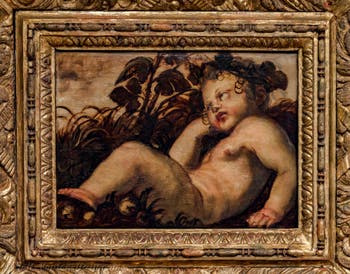
Tintoretto, Autumn Four small paintings adorn the corners of the ceiling of the square Atrium.
These four little "putti" represent the seasons. They were all painted by Tintoretto in 1567.
Jacopo Robusti, Tintoretto “Autumn”
Oil on canvas 1567"Autumn" is a nice little canvas.
One can see in the gaze of this little putto a little mischievous, the memory of the good time spent during the summer.
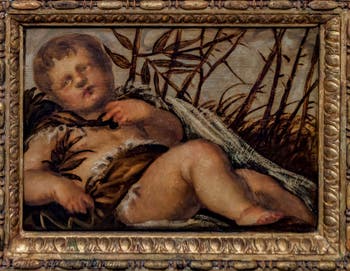
Tintoretto, Winter A few potatoes are on the ground and the curls of the vine frame his face. Not a Bacchus, but the red cheekbones are there!
Jacopo Robusti, Tintoretto “Winter”
Oil on canvas 1567"Winter" is a small moving canvas.
The child lies in waiting, time seems to have stopped, nostalgia is expressed in his eyes.
The features are barely sketched, but his face is particularly expressive. Strongly spring!
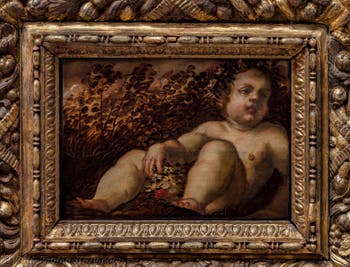
Tintoretto, Spring
Jacopo Robusti, Tintoretto “Spring”
Oil on canvas 1567This is the moment of the awakening of nature, but also of this putto.
It still feels a little sluggish, barely coming out of winter sleep.
The first flowers and colours are there, in the bouquet he holds and in the crown that girds his forehead.
Chubby, well in the flesh, the promises of spring are here!
Jacopo Robusti, Tintoretto “Summer”
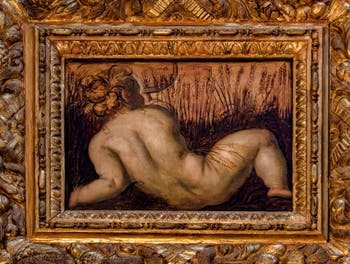
Tintoretto, Summer Oil on canvas 1567
Warmth of tones, glowing sky, it's summer!
It's the time of the harvest!
The putto, less chubby and more muscular than in spring, mows the wheat with ardour, wheats that occupy the bottom of the painting, but also seen lying on his thigh and pricked in his hair.
Atrium Doge's Palace: Tintoretto, Biblical Scenes
On either side of the central ceiling painting of the living room, depicting the "Doge Girolamo Priuli Receiving the Sword and Balance of Justice", are four rectangular paintings made by Tintoretto, painted in a monochrome manner imitating bronze.These four biblical scenes are: "The Judgment of Solomon", "The Queen of Sheba before Solomon," "Esther before King Ahasuerus" and "Samson beats the enemy army."
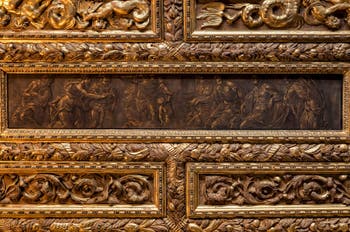
Tintoretto,Judgment of Solomon
Jacopo Robusti, Tintoretto “The Judgment of Solomon”
Oil on canvas (1565-1567)The famous judgment of King Solomon who made him famous and gave him his reputation for wisdom.
We can see well the agitation of the two women, especially that of the real mother, on the one hand, and the tranquillity of the king on the other, while the child, unconscious of what is happening around him and ignoring the threat of the sword ready to slit him, is interested in something that is on the ground.
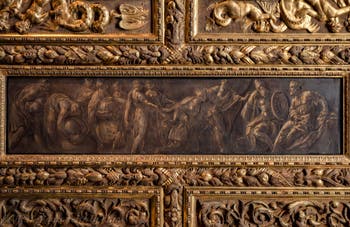
Queen of Sheba before Solomon
Jacopo Robusti, Tintoretto “The Queen of Sheba before Solomon”
Oil on canvas (1565-1567)The Queen of Sheba comes to offer her gifts to King Solomon in an attitude of respect, ready to kneel before him.
A scene that foreshadows the adoration of the Magi.
Jacopo Robusti, Tintoretto “Esther before King Ahasuerus”
Oil on canvas (1565-1567)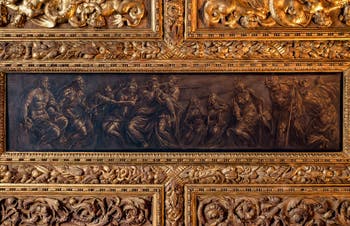
Esther before King Ahasuerus Here we see Esther, adorned with his finest outfits to appear before Ahasuerus, but without permission; hence the movement of anger of the king and the failure of Esther, believing himself lost before this reputed cruel king.
Moreover, the total submission to King Ahasuerus is evident in the attitude of the characters who bow down, head down, in the right part of the painting.
Jacopo Robusti, Tintoretto “Samson beats the enemy army”
Oil on canvas (1565-1567)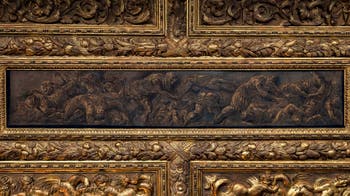
Samson beats the enemy army The donkey jaw that Samson holds when he fights against the Philistines does not stand out very well here.
On the other hand, we can see that the hero does not make a neighbourhood by slaughtering his enemies.
Atrium Doge's Palace in Venice: Paolo Veronese
Three paintings by Paolo Veronese were bequeathed to the Republic of Venice in 1713 by Bertucci Girolamo Contarini: "Christ in prayer, supported by an angel in the garden of the Olives", "Adam and Eve in earthly Paradise" and "Saint John the Evangelist who writes the Apocalypse".After the fall of the Republic, lest they were stolen or damaged, in a palace that became without a master, these paintings by Paolo Veronese were transferred in the commandery of the Maltese Order.
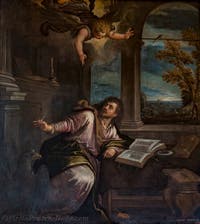
Saint John Evangelist They were then hung in the Procuraties Nuove, the new seat of power under Napoleon Bonaparte.
They have now returned to their place in 1713, and you can admire them again in the Atrium Salon of the Doge's Palace.
Paolo Veronese “Saint John the Evangelist writes the Revelation”
Oil on canvas (1580-1590)The eagle on the left, the attribute of Saint John, represents Christ, and the Angel comes to give him inspiration.
Saint John the Evangelist was then exiled to the island of Patmos where he wrote the Revelation.
Paolo Veronese “Christ praying in the Garden of Olives in Gethsemane”
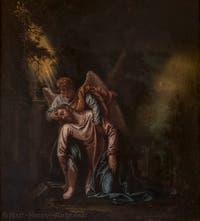
Christ Garden of Olives Oil on canvas (1580-1590)
After the Last Supper, Jesus, overwhelmed, experienced, distressed, is comforted by an angel.
The body of Christ is abandoned in the arms of the Angel, while his dreary gaze shows him tired and very strong at the same time.
His gaze is the only indication of his presence, his whole body and especially his hands, are lifeless.
The chalice, symbol of Passion barely reflects the light that illuminates the Angel and Jesus.
Paolo Veronese “Adam and Eve in the Garden of Eden”
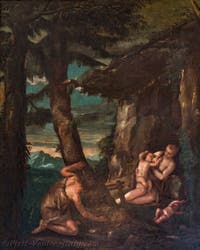
Adam Eve Garden of Eden Oil on canvas (1580-1590)
Strangely titled "in the Garden of Eden" when it is obvious that this scene happens after Adam and Eve have been driven out of earthly Paradise, which is easily seen by the presence of children, and especially because they are both dressed in animal skins.
In the middle of the trees, under a roof covered with foliage, Eve sits in the shade and breastfeeding one of her children while the other is lying at his feet.
Adam is on his knees in front of a fountain.
He is dressed in a beast skin and leaning with his left hand to the trunk of a tree while he collects water from the other in a bowl.
A goat stands behind them.
Atrium Doge's Palace in Venice: Bassano
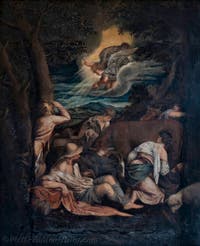
Bassano, Angel announces
Girolamo Da Ponte, Bassano “The Angel announces the birth of Christ to the asleep shepherds”
Oil on canvas (1560)This Announcement to the Shepherds is superbly realized. Note the naturalness of the attitudes of the characters who are particularly "true".
Especially the lower shepherd who smokes his pipe, so modern that it is difficult to imagine that this painting dates from almost five centuries ago.
For the painters of the Bassano era, the task was not easy as successors of Titian and Tintoretto.
Jacopo Bassano manages to "exist", without rejecting the legacy of Titian or Tintoretto, introducing into his painting what was then called "the unfinished".
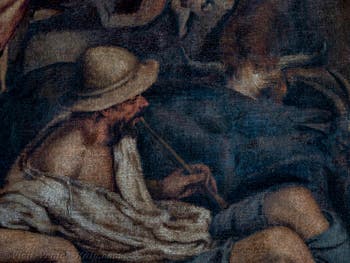
Bassano, Angel announces Marco Boschini (1602-1681) historian and theorist of Italian art of the 17th century said of Bassano:
“with his proud brushstroke... he despised the application and the finish [and created] chaos, so to speak, of indistinct, mixed and confused colours, which, closely and under the eye, resemble rather a disorder than a perfect artifice.
And yet this chaos is such a virtuoso illusion that the eye and ear of the intellect, as long as they do not get lost on the fact, but move away from a distance, are fully satisfied with it and enjoy the suave harmony that a well-tuned instrument can make, when touched by a hand of a master, and of the most sympathetic union that can form a human concert, between Art and Nature.”
Marco Boschini
Art Story Power | Tintoretto Paradise | Architecture | Staircases | Senate Collegio | Atrium
Doge's Palace Art Story | Location | Opening Hours Tickets | Authorizations
Back to Top of Page

